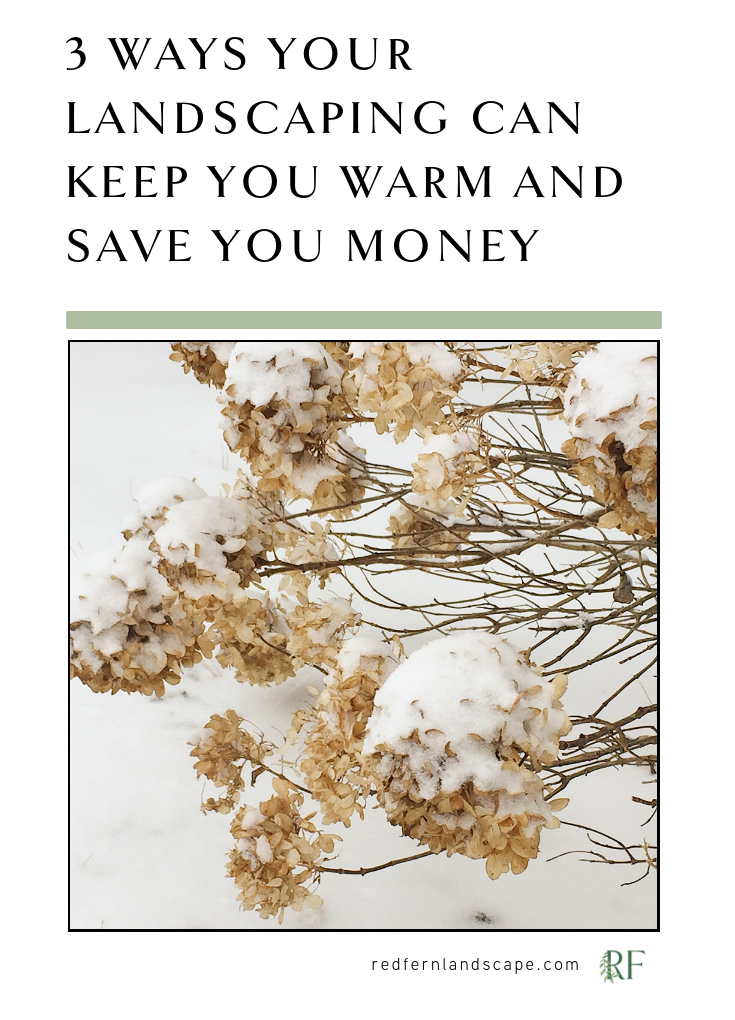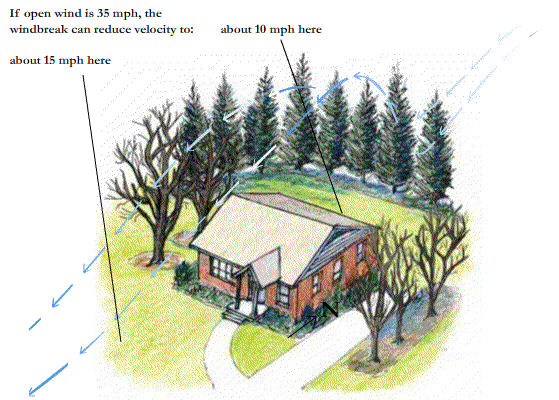Heating costs are expected to rise just about every year – it costs a lot to keep our houses cozy during winter. Growing up in North Carolina, winter didn’t seem like a big deal. However, now that I’ve spent 7 winters in New Hampshire and 3 in Iowa, I know winter is game time. Cold weather doesn’t mess around out here, and we need all the help we can get. And since winter shows up in November and doesn’t leave until mid-April, we’ve got an important and expensive problem on our hands. Luckily, landscape design comes to the rescue again! The US Department of Energy has a few stats to help drive home the point:
- A well-designed landscape can save up to 25% of your home’s energy costs for heating and cooling.
- Windbreaks can cut your heating bills by an average of 30%.
- Well-placed plants can allow passive solar heating to keep your home toasty without bumping up the heat.
Basically, what we want to do is block cold winds from the west and north, and capitalize on sunshine coming from the south. Let’s put your landscaping to work all winter long!

1. PLANT A WINDBREAK.
Windbreaks are plantings that screen our houses from the wind – they slow down wind gusts and send them up and over our homes. And if you live in the Midwest, you KNOW that the wind deserves to be messed with a little. Whether your yard is a wide-open acreage or a modest suburban lot, chances are you have some type of crazy wind tunnel to deal with. Windbreaks reduce the wind chill- that “feels like” temperature that is caused by low air temps combined with the wind speed. If you’re thinking about planting a windbreak, follow these guidelines:
- Block the north and west winds. In the Midwest, we have the Great Plains and Canada to thank for our freezing cold winds, so plant to the north and west of your house for the best protection.
- Plant at the right distance.The goal is to lift the wind up and over your house. To do this, figure out the mature height of the trees you’re using. Multiply that number by ~3 (there’s some wiggle room with this math), and plant the windbreak that distance from your house. So, if the tallest trees you’re using will get 40 feet high, you want that windbreak 120 feet off the house. You can go backwards with this math, too. If your property line is only 60 feet from your house, choose plants that only reach 20 feet at maturity.
- Use a combination of plants for the greatest impact. Combine lower-growing shrubs closest to the house, followed by taller deciduous trees, and finally tall evergreens. This layered planting will block the wind, lift it up and over your house, and capture the snow to keep it from drifting. You’re looking for quick-growing, low-cost, hardy plants to fill in your windbreak without breaking the bank. Some great choices include:
- Evergreens – arborvitae, spruce, pine, red cedar, juniper, fir
- Deciduous trees – oak, hickory, hackberry
- Shrubs – ninebark, dogwood, lilac, sumac
This GIF from the Arbor Day Foundation shows that freezing cold wind pulled up and over your house.

2. INSULATE YOUR HOME’S FOUNDATION WITH PLANTS.
Planting beds along the foundation of the house not only look lovely, they also can lower heating costs. In the right spots, plants will create air pockets that insulate both in summer AND in winter.
PRO STAT: When warm air escapes and cold air enters your home, heating costs can increase by 25%-40%!
The biggest mistake people make is crowding their foundation plantings too close to the house. You have to know how big the plants will be when they mature, and plan for that. You want around 12”-18” of open air space between the walls of your house and the foundation planting beds.
Even if the hydrangeas or junipers you have your eyes on at the nursery are only two feet across in the pot, trust the tag that says it will get six feet wide! Plant those shrubs so that the center is around 3-4 feet off the wall of the house – even if it seems silly when it’s tiny, it doesn’t take long for the plants to grow. Planning ahead will save you time and money, since you won’t have to prune (and risk damaging the plants) or buy new plants when they get too big.
3. WARM UP WITH THE SUN
While we are guaranteed to have windy, cold days in the Midwest winter, we also can count on bright blue sunny skies. This usually happens when – I’m not kidding – it’s too cold to snow. Even when it’s cold outside, that sunshine can be put to work.
PRO STAT: Solar energy can provide between 5-20% of the total energy needed to heat your home in the colder months!
Here are a couple of ways to harness the warmth of the sun, even if you don’t have solar panels:
- Leave some areas to the south of your home open – snow will gather there and reflect radiant heat from sunlight into your house.
- Plant deciduous trees to the south and southwest of your home. (Deciduous trees are the kind that loose their leaves each fall.) They’ll shade your roof and windows all summer, but allow warm sunshine to come in during the winter.
Cold weather can be miserable AND expensive. Plan now for landscaping projects that will reduce your heating costs and make your house more comfortable. Looking for warm-weather solutions for energy efficiency? We wrote about that during the dog days of summer… you can catch up on our post here.
Need to add some landscaping to keep your house cozy? Winter is the best time for design work, so that we can be ready to go in the spring. Let us know if Red Fern can help!
LIke it
pin it
tweet it
email it